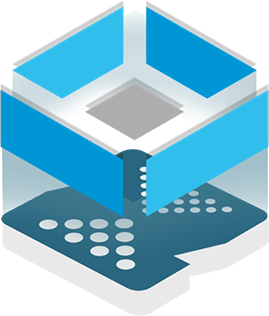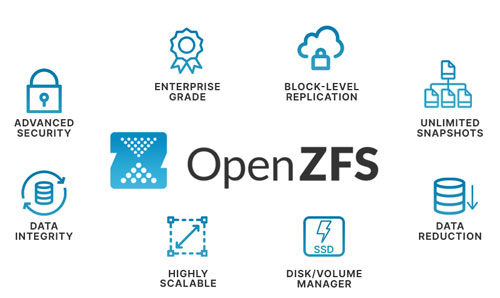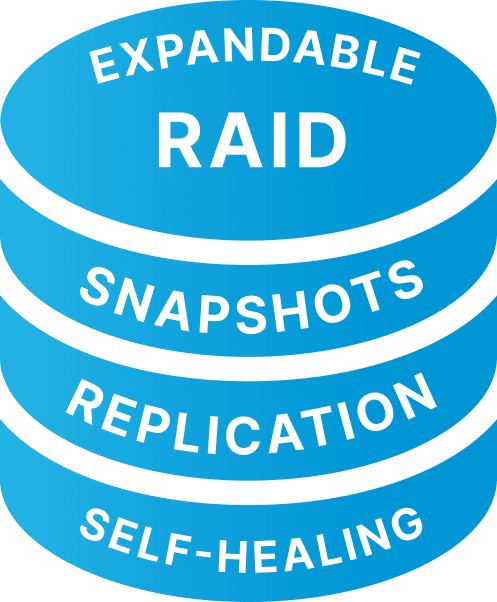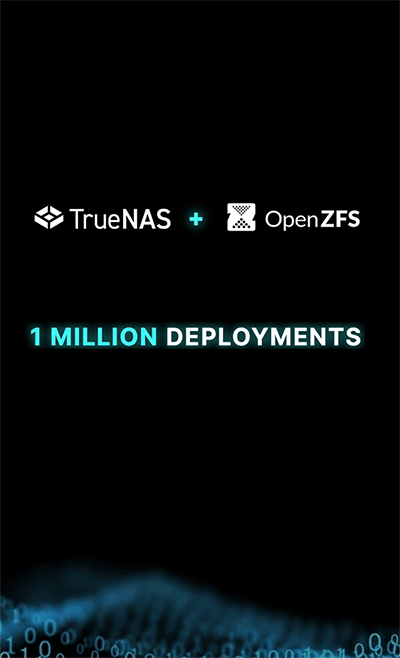
ZFS
TrueNAS makes OpenZFS accessible to millions of people around the world.
Overview

The Zettabyte File System (ZFS™) was developed by Sun Microsystems™ in 2006 to solve the data integrity and protection issues other file systems faced. After Oracle™ acquired Sun, some of the original ZFS engineers founded the OpenZFS™ project to provide continued, collaborative development of the Open Source version. Dubbed the “billion-dollar file system” because of the large investments by Sun, various vendors, and the open source community, OpenZFS changes the rules of data storage by making enterprise features and data protection available to users of all sizes.
- Virtually limitless capacity and scalability with both SSDs and HDDs
- Copy-on-Write architecture for data safety and efficient snapshotting
- Integrated software-defined RAID with checksums and validation
- High-performance transparent compression and inline deduplication
- Native encryption at the disk, pool, or dataset level
- Integrated Read/Write caching with options for all-flash or hybrid pools
- Integrated with FreeBSD, Linux, and many other operating systems
- >1 Million deployments as the basis of TrueNAS® CORE, SCALE, and Enterprise


OpenZFS and TrueNAS
TrueNAS takes the raw power of ZFS even further by creating a comprehensive data sharing and management system that delivers a unified file, block, and object storage on top of ZFS. TrueNAS is often referred to as the “easy button” for ZFS storage with an integrated and powerful Web UI and comprehensive REST API that makes harnessing the power of ZFS possible for all. This is one of the reasons TrueNAS is the most widely deployed ZFS-based storage system with over 1 million installations and counting.
TrueNAS and ZFS protect data in many unique ways including:
Integrated RAID – Software-defined RAID expands protection across disks.
Self-Healing – Automatic detection and repair of any data corruption.
Incremental Snapshots – Frequent snapshots let you roll back file versions easily.
Replication – Replicate data offsite, to the cloud, or to another onsite system.
Backup Target – Integrate with existing IT Backup solutions like Veeam and Asigra.
High Availability – Dual controllers enable maximum uptime on Enterprise systems.
ZFS Concepts and Terms
ZFS is Enterprise and highly scalable, requiring new concepts and terminology to differentiate its practices from standard filesystems:
- ZFS vdev
- A vdev is a top-level RAID “virtual device” compromising one or more drives. A vdev has many configurations including: single disk, stripe, RAIDZ1, RAIDZ2, RAIDZ3, or mirror.
- RAIDz
- RAIDZ Combines disk drives and data storage devices into a single virtual storage device. RAIDZ can use either single (Z1), dual (Z2), or triple (Z3) parity for data protection. If a drive fails, the data can be rebuilt (“resilvered”) to a spare drive to prevent data loss.
- Checksum
- A Checksum is an additional integrity check on data that is written separately from the data. It is continuously used for the detection and repair of data corruption via a “scrub” process.
- Dataset
- A virtual filesystem without the restrictions of a fixed-size partition. Each dataset can be snapshotted, cloned, and configured for any use case and have child datasets with their own distinct properties.
- ZVOL
- ZVOLs are datasets that represent block devices Internet Small Computer Systems Interface (ISCSI) and Fibre Channel (FC).
- Snapshot
- A point-in-time, read-only, copy of a file system or volume that does not get changed when new data is written. Each snapshot can preserve archival data, be replicated to another system, or be used to rollback after a bad event such as malware or ransomware attack.
- ZIL/SLOG
- A “Separate intent log” (SLOG) is a high speed write cache device for storing the “ZFS intent log” (ZIL). It maximizes ZIL performance by aggregating random writes into sequential writes, thereby accelerating write performance and ensuring data integrity during power failure or failover events.
- L2ARC
- With ZFS, the hottest data is cached and read from system RAM. A “Level 2 Adaptive Replacement Cache” (L2ARC) can be added as a second caching layer to accelerate reads by dynamically filling and flushing additional hot data that cannot fit into RAM.
- Copy on Write
- Copy-on-write is a technique used to avoid modifying existing data and instead write new data to a different location. This enables efficient snapshots and avoids data corruption during power failures.
- FSCK elimination
- FSCK, also known as File Systems Checks, are time-intensive processes to verify that checkfile system metadata is OK. ZFS eliminates the need for these checks and the negative performance impacts they have.
- Self-healing
- Self-healing data protection is built-in natively to TrueNAS and ZFS. This gives the file system the ability to automatically recover from drive errors and failures without loss of data or corruption of data.
- Async Replication
- Async replication is a technique for efficiently replicating data to another system for back-up. Only the changed data between snapshots is sent to the backup system.
- Stripesize Control
- Stripesize control enables files to be efficiently laid-out across many drive groups. Databases prefer small stripe sizes, whereas video files are better handled with large stripe sizes. ZFS includes a configurable recordsize, ranging from 4KB to 1MB
- NFSV4 ACLs
- NFSV4 ACLs are powerful enterprise control capabilities for sharing data between users and groups in a file system. NFSV4 ACLs mimic the functions of Windows ACLs and are more fine-grained than simple POSIX ACLs.
- SSD Metadata
- Filesystem metadata can be stored on SSDs for faster performance while large data files can be stored on HDDs for a hybrid storage approach to lower costs.
ZFS, Oracle, and Sun Microsystems are all registered trademarks of Oracle
